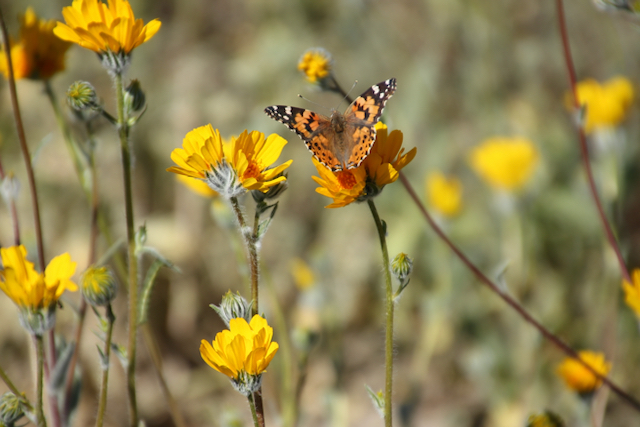Oh No! My Plants Have Holes in Their Leaves!
Are worms or caterpillars eating holes in your plants’ leaves ? Don’t worry, that’s usually a good thing!
Does that surprise you? “Aren’t holes bad?” you ask. “Aren’t they hurting my plants?” “The holes make my plants look ugly!”
Holey leaves are just part of nature. Every healthy garden is an ecosystem that includes native worms and caterpillars. Worms and caterpillars eat leaves, so leaves get holes.
Do you plant to attract pollinators?
Butterflies and moths are some of our garden’s most important native insect pollinators. They lay eggs on the leaves of their favorite trees/shrubs (favorite = the ones their hatchlings love to eat). Those eggs hatch out to be worms (the larval form of moths) or caterpillars (the larval form of butterflies) that eat plant leaves. So, every time you kill a worm or a caterpillar, you’ve killed a moth or butterfly pollinator.

Many native plants rely on moths or butterflies to pollinate them
As you kill native worms and caterpillars, you destroy the pollinators that native (and non-native) plants depend on. Without their pollinators, native plants are pushed closer to extinction. If you live in California, visit www.Calscape.org to discover which butterflies and moths pollinate different kinds of native plants. Click here to see California oak moths swarming a native oak tree in Morro Bay, California.
Many native birds eat worms and caterpillars
If you eliminate those worms and caterpillars, native birds lose a major source of protein. That translates to smaller clutches (number of eggs laid) and ultimately to smaller native bird populations or even to extinction.
Plants don’t mind having holey leaves
Plants grow a bazillion leaves, so if some get chewed on, there are still plenty of leaves left to photosynthesize and make energy for the plants. They may not look pretty but holey leaves continue to photosynthesize, too. Very few – if any – worms or caterpillars cause permanent damage or kill a plant. This applies to native and non-native plants, alike.
The worm/caterpillar stage is very brief
Moth/butterfly eggs hatch out to worms/caterpillars. Over days or even months, worms/caterpillars go through different larval stages, then metamorphose to either pupa (moths and some butterflies) or chrysalises (only butterflies). Some moths spin cocoons.
Within a week or so, an adult moth or adult butterfly emerges, then flies away in search of nectar and a place to lay eggs for the next generation. Watch the fascinating process here.
Leave them be
Do you get the idea that the vast majority of these insects do far more good than harm? Don’t kill them. If your plants really, truly are facing permanent damage, first try to pick off the worms/caterpillars and place them on a table in the open or a sidewalk or top of a fence where a hungry bird might find them.
If there are way too many critters to pick off, consider using a Bug Blaster hose end nozzle to blast them off the branches (Their soft bodies can’t sustain the damage from the sharp spray of water, nor the fall to the ground.) If that doesn’t work, try Bt (Bacillus thuringiensis), which is a biological pesticide that kills only worms and caterpillars (some formulations kill mosquito larvae, too!). Bt is only a last resort.
Rather than panic, wear those holey leaves proudly. They show your garden as part of nature!
Did You Know:
- There are more than 140,000 species of moths and butterflies worldwide?
- While butterflies pollinate during the day, most moths pollinate at night
- The “eye spot” markings on butterfly and moth wings are intended to make them look like large animals – their strategy to scare away predators
Want to know more about the similarities and difference between moths and butterflies? follow this link.







